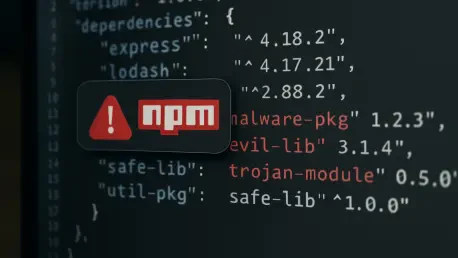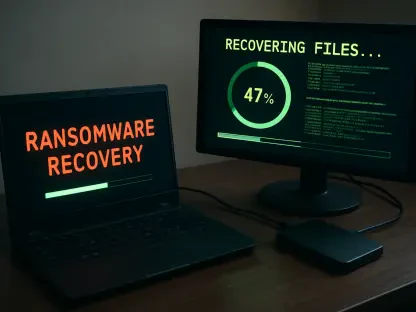The software development landscape is under siege from an insidious threat: malicious npm packages that infiltrate the Node.js ecosystem, compromising the very foundation of countless applications. With over 86,000 downloads of 126 harmful packages tied to a single campaign since August of last year, the scale of this cyberthreat is staggering, exposing vulnerabilities in a platform trusted by millions of developers worldwide. This review dives deep into the mechanisms behind these attacks, examining their sophisticated tactics, real-world impacts, and the urgent need for evolved security measures to protect the software supply chain.
Understanding Malicious NPM Packages
At the heart of the Node.js ecosystem lies npm, or Node Package Manager, a repository hosting millions of open-source libraries that developers rely on daily. Malicious npm packages exploit this trust, embedding harmful code within seemingly legitimate modules to infiltrate systems, steal data, or disrupt operations. These threats have surged in relevance as software supply chain attacks become a favored vector for cybercriminals seeking to exploit the interconnected nature of modern development.
The significance of this issue cannot be overstated, given the widespread dependency on open-source components in both enterprise and individual projects. Attackers leverage npm’s accessibility to distribute malware, often targeting unsuspecting developers who install packages without thorough vetting. This growing menace underscores a critical gap in cybersecurity, where the convenience of rapid development clashes with the need for robust protection.
As organizations increasingly integrate third-party libraries into their workflows, the risk of compromise escalates, turning a tool meant for efficiency into a potential backdoor for adversaries. This review aims to unpack how these packages operate within the ecosystem, shedding light on their deceptive strategies and the broader implications for digital security.
Core Mechanisms of Attack
Remote Dynamic Dependencies (RDD) Exploitation
One of the most cunning tactics employed by attackers involves Remote Dynamic Dependencies, a method that hides malicious code by outsourcing it to external servers. Unlike traditional dependencies stored within the npm registry, RDD allows a package to fetch harmful payloads from attacker-controlled URLs during installation. This approach renders the package benign under static analysis, as no malicious content appears in the registry metadata.
Security tools that rely on scanning package contents before runtime are often blindsided by this technique, unable to detect the external fetch that introduces the threat. The invisibility of these dependencies to conventional checks creates a significant loophole, enabling attackers to bypass established safeguards with alarming ease.
This exploitation of RDD highlights a fundamental flaw in current detection paradigms, where the focus on static data overlooks dynamic behaviors. As a result, developers may unknowingly integrate compromised packages into critical systems, amplifying the potential for widespread damage.
IP-Based Targeting Tactics
Beyond concealing code, attackers have refined their approach with highly selective targeting based on IP addresses, as seen in sophisticated campaigns. By identifying the source of an installation request, malicious actors can deliver benign content to security researchers or sandboxes while reserving harmful payloads for corporate networks or cloud environments. This customization adds a layer of stealth that complicates detection efforts.
Such precision targeting demonstrates an advanced understanding of defensive strategies, allowing attackers to evade scrutiny from those most likely to uncover their schemes. Corporate systems, often the primary targets due to their valuable data, face heightened risks as tailored malware slips through unnoticed.
The ability to adapt payloads dynamically based on user context marks a troubling evolution in cyberthreats, pushing the boundaries of traditional security measures. This tactic not only increases the likelihood of successful infiltration but also challenges organizations to rethink how they monitor and respond to incoming threats.
Slopsquatting and AI Hallucinations
A newer and equally deceptive vector, known as slopsquatting, capitalizes on the rise of generative AI tools in development workflows. Large language models, such as those powering code assistants, sometimes suggest fictitious package names that appear plausible but do not exist in legitimate repositories. Attackers preemptively create these fake packages, waiting for developers to install them under AI guidance.
Unlike typosquatting, which relies on misspellings of real packages, slopsquatting evades detection because the fabricated names bear no direct resemblance to existing ones, slipping past alert systems. This exploitation of AI hallucinations preys on human trust in automated recommendations, turning a productivity tool into a liability.
The intersection of AI and cybercrime introduces a novel attack surface, where the very innovations meant to streamline coding become conduits for compromise. As developers increasingly lean on such technologies, the potential for widespread exploitation through slopsquatting grows, demanding vigilance beyond conventional checks.
Emerging Trends in Software Supply Chain Threats
Software supply chain attacks have evolved into a realm of unprecedented complexity, with tactics like RDD and slopsquatting showcasing the ingenuity of modern cybercriminals. These methods exploit obscure features of package managers, reflecting a broader shift toward covert operations that prioritize stealth over brute force. The subtlety of these attacks often delays detection, allowing threats to persist within systems for extended periods.
The integration of AI into development environments further amplifies the attack surface, as tools meant to enhance efficiency inadvertently promote malicious content. This trend points to a dual challenge: addressing technical vulnerabilities while mitigating human reliance on potentially flawed automated suggestions. Cybercrime’s adaptation to these advancements signals a need for equally innovative defenses.
Moreover, the focus on targeted, niche exploits indicates a maturing threat landscape, where attackers seek high-value targets with minimal exposure. This move away from mass campaigns toward precision strikes complicates the task of securing sprawling software ecosystems, urging a reevaluation of how supply chain integrity is maintained across industries.
Real-World Impact and Case Studies
The tangible consequences of malicious npm packages are evident in campaigns that have already caused significant disruption, with one notable operation amassing over 86,000 downloads across 126 packages since August of the prior year. Industries ranging from finance to technology have felt the sting of these attacks, as compromised packages infiltrate build processes, exposing sensitive data and critical infrastructure to risk.
Specific instances reveal the depth of the challenge, as initial waves of malicious uploads are removed only for new ones to surface over subsequent months, evading immediate notice. Organizations struggle with the dual burden of identifying infected systems and preventing further incursions, often lacking the tools to detect dynamic threats in real time.
The persistence of such campaigns, despite cleanup efforts by npm’s security team, illustrates the uphill battle faced by the development community. Each case serves as a stark reminder of the cascading effects of supply chain vulnerabilities, where a single compromised dependency can jeopardize entire networks, demanding urgent and comprehensive responses.
Challenges and Limitations in Detection
Detecting malicious npm packages remains a formidable obstacle, primarily due to the shortcomings of static analysis tools in addressing dynamic threats like RDD. These tools, designed to scan package metadata before installation, fail to account for external code fetches that occur at runtime, leaving a critical blind spot in security protocols.
Even as cleanup initiatives remove known threats, the continuous emergence of new malicious uploads highlights the persistent nature of this problem. Attackers adapt quickly, exploiting gaps in monitoring and response mechanisms, while organizations grapple with the scale and speed required to keep pace with evolving tactics.
Beyond technical limitations, human factors compound the issue, as developers often prioritize speed over scrutiny when selecting packages, especially under AI guidance. Addressing these intertwined challenges necessitates a holistic approach, combining advanced tools with education to fortify both systems and decision-making against exploitation.
Future Outlook for NPM Security
Looking ahead, the security of npm and similar ecosystems hinges on the adoption of advanced detection methods, such as dynamic analysis and behavioral monitoring. These techniques, which focus on runtime activities like suspicious network requests, offer a promising avenue for identifying threats that static scans miss, potentially closing existing gaps.
The long-term implications of AI-driven attacks also loom large, as the proliferation of generative tools in development could further expand vulnerabilities if left unchecked. Security practices must evolve to incorporate safeguards against AI hallucinations, balancing innovation with risk mitigation to protect the integrity of coding environments.
Ultimately, safeguarding the software supply chain will require a collaborative effort, uniting platform maintainers, developers, and security experts to anticipate and counter sophisticated threats. The trajectory of npm security depends on proactive adaptation, ensuring that defenses keep pace with the relentless ingenuity of cybercriminals.
Key Takeaways and Final Assessment
Reflecting on this review, it becomes clear that malicious npm packages stand as a pressing cyberthreat, exploiting technical loopholes and human trust with devastating precision. Current countermeasures, heavily reliant on static analysis, fall short against dynamic tactics, underscoring an urgent need for updated security paradigms that embrace behavioral monitoring and runtime scrutiny.
The impact on software development and cybersecurity landscapes remains profound, as supply chain attacks redefine the risks of open-source dependency. Existing strategies, while valuable, require enhancement to address the stealth and adaptability of modern campaigns, ensuring that the ecosystem does not remain a fertile ground for exploitation.
In the aftermath of this analysis, actionable steps emerge as critical for stakeholders. Developers are encouraged to rigorously vet package names and monitor network activity during installations, while platform maintainers work to enhance detection frameworks. Looking forward, the focus shifts to fostering industry-wide collaboration, integrating cutting-edge tools, and educating users on emerging risks, paving the way for a more resilient software supply chain.









